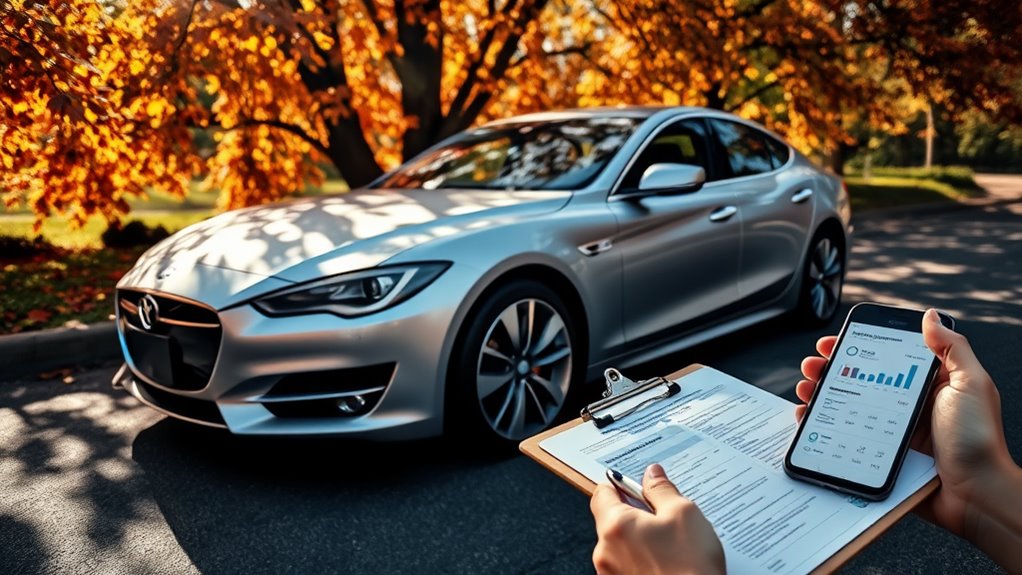
If you often borrow or rent cars, understanding non-owner car insurance is vital. It provides essential liability coverage, protecting you from costs related to bodily injury and property damage. This type of policy can be especially valuable for those who use ride-sharing services or company vehicles. However, there are more nuances to take into account that could impact your decision. Let’s explore how this insurance can fit into your driving needs.
If you frequently borrow cars or rent vehicles, non-owner car insurance can be a valuable solution. This type of insurance primarily provides liability coverage, which means it protects you against bodily injury and property damage claims when you’re driving a vehicle that you don’t own. Many people find this coverage essential, especially if they often borrow cars from friends or family who aren’t listed on their own insurance policies.
Non-owner car insurance offers vital liability coverage for those who regularly borrow or rent vehicles, protecting against injury and damage claims.
It’s particularly useful for individuals who may need to file an SR-22 or FR-44 to reinstate their driver’s license, as having non-owner insurance can help meet state requirements.
This insurance is designed with a specific target audience in mind. It’s perfect for frequent renters or borrowers who need a safety net when behind the wheel of someone else’s car. You might also find it beneficial if your employer requires you to have liability insurance for company vehicle use or if you drive for ride-sharing services like Uber or Lyft.
Even when renting exotic or luxury cars, non-owner car insurance can provide essential coverage, allowing you to enjoy your experience without worrying about potential financial repercussions in the event of an accident.
One of the most attractive aspects of non-owner car insurance is its affordability. Because it doesn’t include extensive or collision coverage, the premiums are often much lower than traditional insurance policies. In some states, you might find monthly rates that are under $20, and annual costs typically range from $200 to $500. Lower premiums are particularly appealing for those who do not own a vehicle.
However, keep in mind that prices can vary based on state regulations and insurance providers. This flexibility makes non-owner car insurance an appealing choice for those who only need coverage for short periods, such as when moving between vehicles or temporarily borrowing a car.
For drivers required to file SR-22 or FR-44 forms due to past violations, non-owner insurance becomes even more important. Many states mandate proof of coverage to comply with financial responsibility laws, and this type of insurance helps guarantee you meet those requirements.
This is particularly important for higher-risk drivers, as maintaining insurance can prevent further complications related to their driving record.
If you’re someone who frequently rents vehicles for personal or business use, non-owner car insurance provides essential liability protection. Whether you’re on a business trip or enjoying a vacation, this coverage can safeguard you against the unexpected costs associated with accidents.
It’s also beneficial for short-term rental situations, as it allows you to drive confidently without worrying about missing insurance.
Lastly, maintaining continuous coverage through non-owner car insurance can help you avoid gaps in your insurance history. These gaps can lead to higher premiums in the future, so keeping this policy in place while you move between vehicles helps classify you as a lower-risk driver.
In the landscape of car insurance, non-owner car insurance acts as a safety net, catching you before you fall into the uncertainties of borrowing or renting. Just as a sturdy umbrella protects you from unexpected rain, this coverage shields you from potential liabilities. By opting for non-owner insurance, you’re not just saving money; you’re weaving a continuous tapestry of responsible driving history, ensuring you’re ready for whatever the road has in store. Drive with confidence and peace of mind.
Understanding Non-Owner Car Insurance Costs
When considering non-owner car insurance costs, you’re looking at several key factors, including age, driving history, and your ZIP code. These elements play a significant role in determining your premiums. While annual costs typically range from $200 to $500, understanding the nuances of coverage options and local rates can lead to unexpected variations in pricing. What other factors might influence your final premium? The answers may surprise you.
When you find yourself frequently borrowing or renting cars but don’t own a vehicle, non-owner car insurance can be a smart choice to contemplate. This type of insurance primarily provides liability coverage, focusing on bodily injury and property damage you may cause while driving. However, it’s vital to understand that it doesn’t cover damages to the vehicle you’re driving or personal injuries you may incur. Instead, this insurance follows you as the driver, making it an effective secondary coverage option if you often borrow or rent cars.

One of the key benefits of non-owner car insurance is that it helps maintain a continuous insurance coverage history. This is particularly important for individuals who are shifting between vehicles or who live outside of households with vehicle owners. If you find yourself in a situation where you’re frequently renting or borrowing cars, this insurance can prevent coverage gaps that could lead to higher premiums in the future. Fundamentally, it acts as a safeguard against being labeled a high-risk driver due to inconsistent insurance coverage history. Many individuals opt for this insurance to ensure they remain compliant with state insurance requirements.
The cost of non-owner car insurance is generally lower than full-coverage policies, as it typically excludes extensive and collision coverages. Factors influencing premiums include your age, driving history, and even the ZIP code where you live, as local accident and crime statistics can impact rates. Additionally, the type of coverage options you choose, such as Uninsured/Underinsured Motorist coverage, can also affect your premium. You might find that the annual costs for non-owner policies range between $200 to $500, which is considerably more affordable compared to rental car insurance, which can average about $50 per day.
When you’re ready to obtain non-owner car insurance, it’s important to shop around and compare quotes from multiple insurance providers. Most major companies offer these policies, but smaller insurers may not. Necessary documents you’ll need include your driver’s license number and personal information. Adjusting coverage limits can also influence your premium costs, so consider what level of protection you truly need. If you find several quotes that suit your budget, you can negotiate for a better rate based on competing offers.
In scenarios where you need to maintain a valid driver’s license through state programs like SR22 or FR44, non-owner insurance becomes even more relevant. It’s also beneficial for those who frequently drive without being listed on someone else’s policy.
However, keep in mind that this insurance won’t cover rental reimbursement, extensive, or collision damages. As you navigate the options, consider your unique driving habits and insurance needs carefully. Ultimately, non-owner car insurance can offer a practical solution for individuals who rely on borrowed or rented vehicles, allowing you to drive with peace of mind without incurring excessive costs.
In summary, understanding non-owner car insurance costs can feel like maneuvering through a maze, where each turn reveals new variables to evaluate. By recognizing how factors like your age, driving history, and location influence premiums, you can make informed decisions. Comparing quotes and adjusting coverage options will help you find a policy that fits your needs without breaking the bank. Ultimately, being proactive in your research allows you to secure the best coverage at a reasonable price.
Top Questions About Non-Owner Car Coverage
If you’re considering non-owner car coverage, you likely have some key questions. You might wonder about what’s included—like bodily injury or property damage protection—and if you qualify for this type of insurance. Costs are another factor, as non-owner policies tend to be more affordable than traditional ones. Understanding these aspects is essential for making an informed decision. So, what else should you know?
If you frequently borrow or rent a vehicle but don’t own one, non-owner car coverage might be the perfect solution for you. This type of insurance provides liability coverage specifically designed for drivers like you, who need protection without the need to own a vehicle. Non-owner car insurance covers you directly, not a specific car, making it versatile for those who frequently find themselves behind the wheel of borrowed or rented vehicles.

One of the main purposes of non-owner car coverage is to help you avoid financial risks if you’re involved in an accident. Regularly borrowing or renting a vehicle means you could face significant liabilities if the unexpected occurs. Non-owner policies not only offer bodily injury and property damage liability coverage but can also provide additional protection when the vehicle owner’s insurance falls short. This is particularly useful for those who might need extra coverage due to limited liability limits on the car owner’s policy. Additionally, non-owner coverage can be beneficial in situations where you may not be the primary driver.
If you’ve had past driving infractions that require SR-22 coverage, this type of insurance can fulfill that requirement.
When evaluating non-owner car insurance, it’s important to understand the coverage options available. Most policies will include bodily injury and property damage liability coverage, and you may also find options for uninsured and underinsured motorist protection. This guarantees that if you’re in an accident with a driver who lacks sufficient insurance, you’re not left to cover the costs on your own. Some policies may also offer medical payments or personal injury protection. Moreover, the owner’s auto insurance serves as primary coverage, while your non-owner policy acts as secondary coverage, which can help fill gaps in liability limits.
However, keep in mind that non-owner coverage doesn’t protect against damages to the vehicle you’re driving or injuries you might sustain while driving.
Eligibility for non-owner car insurance is generally straightforward. If you frequently drive but don’t own a vehicle, this insurance is available for you. It helps maintain continuous coverage, which is vital for avoiding gaps that can lead to higher future premiums. This coverage offers peace of mind for those who occasionally need a vehicle but want a cost-effective solution compared to traditional car insurance.
Purchasing non-owner car insurance is relatively simple. You can obtain quotes from major insurance companies as well as smaller ones, so it’s wise to compare options to make certain you’re getting the best value. During the purchase process, be prepared to provide personal and driving history information. Because non-owner policies have fewer requirements than traditional car insurance, they’re generally easier and quicker to acquire.
Cost is another important factor to keep in mind. Non-owner car insurance is typically more affordable than standard car insurance. On average, you might pay around $325 annually, though rates can vary based on your state and individual insurer. Factors like your driving history and the coverage limits you choose will influence your premium.
For frequent renters, purchasing non-owner insurance can lead to significant savings compared to relying solely on rental car insurance.
Conclusion
In the world of car insurance, non-owner coverage can be a hidden gem for those who don’t own a vehicle but frequently drive. It offers essential protection while keeping your costs down. So, why leave yourself unprotected when borrowing a friend’s car? By understanding your options and the specifics of coverage, you can make informed decisions that suit your lifestyle. Remember, peace of mind isn’t just for car owners—it’s for anyone behind the wheel.
